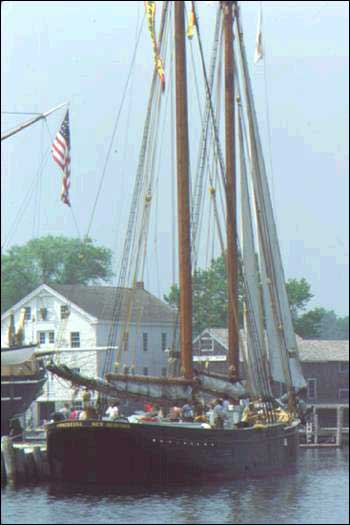Whatever Happened to the Effie M. Morrissey
From the files of The Gazette September 18, 1997.
The Effie M. Morrissey was built at the James and Tarr Yard in Essex, Mass., for the John F. Wonson Company and Capt. William E. Morrissey during the winter of 1893-1894. Designed by George M. McClain, the vessel measures 152 feet long to the spar, with a hull length of 112 feet and a breadth of 24 feet, five inches. It draws 13 feet of water, is 120 gross tons, carries almost 8,000 square feet of sail and has a 295 horse power diesel engine. Built as a sailing schooner for use in the deep sea fishery, the ship was christened Effie M. Morrissey after one of the captain's daughters, and launched on Feb. 1, 1894. Capt. Morrissey and his son, and later other Wonson captains, sailed the ship until March 1905 when it was sold to Capt. Ansel Snow of Digby, N.S., who also used it in the deep-sea fishery.
The Effie M. Morrissey had a Newfoundland connection almost from the time of its launch, as the Morrisseys and other captains fished in Newfoundland waters. In 1913 the ship was purchased by a Newfoundlander, Harold Bartlett of Brigus, who used it as a fishing schooner. In 1925 he sold it to his brother, noted Arctic explorer Capt. Bob Bartlett, who had an auxiliary engine installed and the hull reinforced so he could use the vessel in Arctic ice.
For most of the 20 years which followed, Bartlett undertook yearly Arctic voyages ferrying teams of scientists who conducted experiments and collected flora, fauna and scientific data from a number of Arctic sites. He also collected northern animals (polar bears, musk oxen) for American zoos, and carried passengers, who often included the sons of wealthy Americans, sent on these voyages for adventure. The first of these, David Putnam, later wrote about his experience in several issues of The Youth's Companion. During the Second World War, the Effie M. Morrissey -- with Bartlett at the helm -- was employed by the United States government carrying supplies to American bases in the Arctic.
Bob Bartlett died on April 28, 1946. Shortly thereafter the Effie M. Morrissey was sold for holding freight, but in December 1947, while docked in Flushing, New York, a shipboard fire resulted in a decision to scuttle it in order to put the fire out. Henrique Mendes, an American citizen of Cape Verde Island descent, bought the burned out hulk, had it towed to New Bedford for repairs, renamed the ship Ernestina after one of his daughters, and sailed it to Cape Verde where it was reregistered. For the next 10 years the Ernestina was operated as a packet boat, transporting people and cargo between Brava, Cape Verde Islands and New England ports. Replaced on the transatlantic run by a steamship service in 1957, it was used for a number of years in the inter-island trade at Cape Verde, retiring in 1973.

Photo by Terry F. Ridings. Courtesy of Archives and Special Collections (Coll - 001, 1.10), Memorial University of Newfoundland, St. John's, NL.
In 1982, after a number of years of planning and major repairs, the Ernestina returned to the United States as a gift of the Cape Verde government, with the stipulation that it be used for educational and cultural purposes. Under the jurisdiction of the Massachusetts Schooner Ernestina Commission, it has been operated since 1983 as a training ship.
Archives and Special Collections contains only a small portion of the records of the Effie M. Morrissey, specifically the engineer's logs for the period 1942-43, when the vessel was in the service of the United States government. These logs, compiled by engineers Leonard A. Gushue and George G. Pomeroy, give a very comprehensive account of the vessel's engine room operations, speed, distance covered, weather and other conditions. There are a few related documents: manifests, tally sheets, invoices, schematics. These records provide a brief, but interesting, glimpse of the workings of the engine room on a ship originally built and operated as a sailing vessel. They were presented to the Centre for Newfoundland Studies by Rupert W. Bartlett, nephew of Capt. Bob Bartlett, in the 1970s.
There are also 12 color slides of and a brochure concerning the ship which date from 1987, a gift of Terry F. Ridings of Sidney, B.C., who was also the photographer. The brochure was produced by the Bristol County Development Council for the Schooner Ernestina Commission. There are also copies of three sheets of line drawings by Southmayd Hatch and Thomas A. Soyster done while the ship was on McWilliams Dry Dock, Staten Island, New York, in April 1931. These copies were reproduced by the Newfoundland Historic Parks Association, which presented a copy to the archives in 1995.




